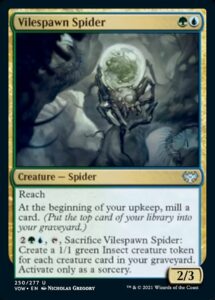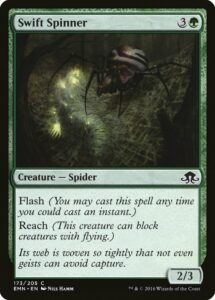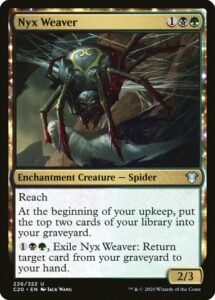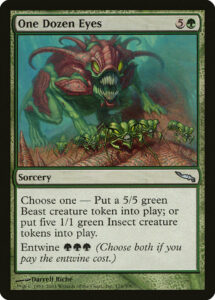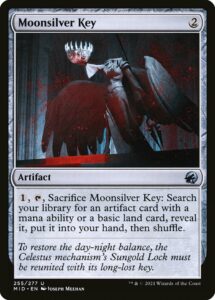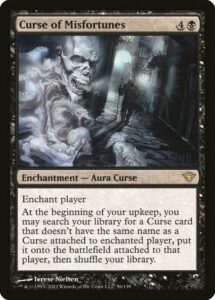The original Innistrad featured Spider Spawning, a subtle card that slyly was one of the best things you could do in the Limited format. Shadows over Innistrad followed up with a different take on self-mill with Rise from the Tides (an archetype first covered in this very column).
Innistrad: Midnight Hunt featured both black-green and green-blue self-mill decks, but with Ghoulcaller’s Harvest being both a rare and wholly aggressive, it was much harder to live the dream and be a dedicated, consistent self-mill deck. Instead, Midnight Hunt decks aimed to generate value via Disturb and Flashback rather than fueling a single, massive effect.
Innistrad: Crimson Vow returns to form with Vilespawn Spider, an actual spider that presents the theoretically easiest ever quest: fill your deck with creatures, then win with a creature. Where Spider Spawning demanded your deck balance creatures and spells, and Rise from the Tides challenged you to stay alive with minimal creatures and maximum spells, this buff spider purports to give you the best of both worlds.
Yet it comes up quite short, despite the easy ask. So today, we’ll examine the design of the card, ability by ability, to see just why it doesn’t stack up.
2/3 Reach for 2
To start with, Vilespawn Spider is an above-rate creature. A 2/3 is by no means massive, but those stats usually cost 3 mana. It’s very good at keeping you alive and annoying your opponent for the first few turns of the game. A little speed bump can be exactly what a Spider Spawning deck wants in the absence of a card like to Gnaw to the Bone that wholesale invalidates damage.
There are two ways of considering what Vilespawn Spider‘s high rate suggests. On the one hand, you can see solid stats as indicative of the spider’s power—it does a good job of keeping you alive. Then, once it loses its usefulness, you cash it in for an army. On the other hand, its aggressive costing is indicative of its ability’s power—with a high baseline rate, there’s not a lot of room left for a powerful ability. Yes, the ability is gated behind sacrificing it, spending four mana at sorcery speed, and having a fully stocked graveyard—so it presumably doesn’t add much, if anything, to the card’s mana cost—but something that’s already good has less room to be much better.
At the beginning of your upkeep, mill 1.
Self-mill is an inherently Spike-y thing to do. To a less competitive player, it’s usually not fun throwing away your spells and is especially frustrating when you carelessly toss the best card in your deck. Still, once you see its power in a dedicated deck, the more cards you can toss, the happier you are.
The thing is, Mill 1 isn’t much. It’s not nothing, but if you play Vilespawn Spider on turn 2 and it lives for four turns, it’ll probably have milled two spells (ideally creatures) and two lands. It’s nowhere near as good at quickly filling your graveyard as a Nyx Weaver, Otherworldly Gaze, or Mulch. It’s intended as a nice little bonus, not the source of its source. And while it can theoretically kill you, you can turn it off whenever you want by cashing the Spider in for insects.
This ability does lose a fraction of a point for its antisynergy with Cruel Witness. Yes, a dedicated self-mill deck wants to throw its entire deck away (though it’s easier to deck in Crimson Vow compared to most other Limited formats), but it’s nice being able to keep what you Surveil now and then.
Create lots of 1/1s
Obviously, 1/1 insects are much weaker than the 1/2 Reach spiders that Spider Spawning creates or the 2/2 zombies from Rise from the Tides. An army of 1/2s defend exceptionally well, and an army of 2/2s kill quickly. Those cards needed to be cast for at least 5 to meaningfully impact a game state, meaning Vilespawn Spider needs even more to be effective. That’s almost certainly why the card is so aggressively costed—you’re not likely to get much bang for your buck even if you make 5 tokens. You really need 8 or more tokens to apply meaningful pressure and your spider is vulnerable to removal if it’s a clear threat.
The ability being sorcery speed and requiring tapping weakens it. Those tweaks are important as they prevent you from manifesting an army out of nowhere and making combat a nightmare for your opponent. Remove both restrictions and the mana cost likely jumps to 6 or 7, but the card is weaker for having those necessary restrictions.
Context is key
The real thing that weakens Vilespawn Spider‘s token generation is context. Without Flashback, it’s simply hard to generate value over time from self-mill. You need benefits before generating an army of insects to reward you for your trouble and stall until the pivotal moment. Disturb and cards like Skywarp Skaab do let you accumulate advantage from stocking your graveyard with creatures, but they do so by removing creatures from your graveyard. Alongside such antisynergistic cards which consume its fuel, Vilespawn Spider (and other cards like Moldgraf Millipede) is an enabler with its weak self-mill ability, not a payoff with a powerful token generation ability.
Ostensibly, you can make up for consuming your graveyard via Exploit refueling your graveyard or using an Overrun effect to convert a moderately-sized army of 1/1 Insects into a formidable fighting force. However, there aren’t many cards with Exploit in Crimson Vow and the two blue commons don’t impress—Stitched Assistant sacrifices board presence to cast a one mana Opt, while Repository Skaab both has limited spell options in blue and green and makes you want to dilute your deck with noncreature spells.
Finally, once you make your insects, there’s little to do with them. The closest thing there is to an Overrun is a Glorious Sunrise or Spiked Ripsaw.
Less is more
All of these factors combine to make Vilespawn Spider so much less than it could be. I’ve had the card in a twenty creature self-mill deck and never wanted to crack it, nor have I ever been on the receiving end of anything more than a midsized creature with a Dream Twist stapled on. Perhaps the card has more power than I give it credit for, but I believe that its low power level is demonstrative of smart design, not an accident.
The original Spider Spawning deck was incredible in that it converted a bunch of unplayable draft chaff into the most powerful deck in Innistrad Limited. It also was frustratingly uninteractive given Innistrad’s weak graveyard interaction and Limited’s general dearth of sweepers. Once Spider Spawning resolved, you might not be able to win immediately, but it was almost impossible to lose.
Rise from the Tides responded by being aggressively slanted, where your tokens couldn’t even block for a full turn cycle. Wizards knows that it needs to be careful with these effects for fear of creating unstoppable cards. Vilespawn Spider needs to tap to activate its ability so your opponent at least has a chance to stop it. And its incredibly easy deckbuilding puzzle (play lots of creatures, all of which can block) means that the payoff shouldn’t be as potent as Rise from the Tides (which demanded nearly creatureless decks).
Vilespawn Spider is a callback to archetypes of Innistrads past. It does so without replicating their powerful but sometimes problematic play patterns. While it’s perhaps disappointing that the spider is weaker than it could be, it’d likely cause serious problems if it were stronger. That restraint is indicative of thoughtful game design, not a missed opportunity.
And that, dear reader, is all we have to say about Vilespawn Spider for today.
Zachary Barash is a New York City-based game designer and the commissioner of Team Draft League. He designs for Kingdom Death: Monster, has a Game Design MFA from the NYU Game Center, and does freelance game design. When the stars align, he streams Magic (but the stars align way less often than he’d like).

